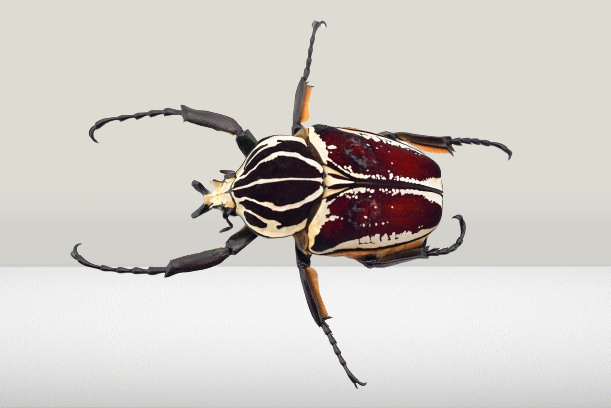In the realm of the insect world, few creatures command attention quite like the Goliath beetle. With its impressive size, striking appearance, and fascinating behaviors, the Goliath beetle stands as a true giant among its six-legged brethren. Found primarily in the rainforests of Africa, these magnificent insects captivate the imagination of entomologists and nature enthusiasts alike, offering a glimpse into the wonders of the natural world.
Belonging to the family Scarabaeidae, Goliath beetles are among the largest beetles on the planet, with some species reaching lengths of up to four to five inches (10 to 12 centimeters). Their robust bodies are adorned with striking colors and intricate patterns, ranging from metallic greens and blues to vibrant reds and oranges. These dazzling hues serve both as camouflage and as a means of communication, allowing Goliath beetles to blend into their surroundings and attract potential mates.
One of the most remarkable features of Goliath beetles is their incredible strength. Despite their relatively small size compared to other animals, Goliath beetles possess impressive physical prowess, capable of carrying objects many times their own weight. This strength is due in part to their large, powerful mandibles, which they use to crush and manipulate food, as well as to defend themselves against predators and rivals.
While Goliath beetles are primarily known for their imposing size and strength, they also exhibit fascinating behaviors and life cycles. Like other beetles, Goliaths undergo complete metamorphosis, starting their lives as eggs laid in rotting wood or decaying vegetation. After hatching, the larvae, known as grubs, spend several months feeding voraciously on organic matter, growing larger and stronger with each molt.
As they near the end of their larval stage, Goliath beetle grubs undergo a remarkable transformation, forming a pupa within a protective cocoon. Inside this cocoon, the pupa undergoes metamorphosis, gradually developing into the adult beetle. After several weeks, the fully formed adult emerges from the cocoon, ready to embark on its brief but spectacular life as a Goliath beetle.
During their relatively short adult lifespan, Goliath beetles focus primarily on reproduction, engaging in elaborate courtship rituals to attract mates. Male Goliath beetles use their formidable mandibles to wrestle with rivals and assert dominance, while females assess potential partners based on their size, strength, and vigor. Once a suitable mate is found, the female lays her eggs in a suitable substrate, usually near a food source for the emerging larvae.
Despite their formidable appearance, Goliath beetles are relatively gentle creatures, posing little threat to humans. They are primarily herbivorous, feeding on ripe fruits, sap, and nectar, and playing important roles in pollination and seed dispersal within their ecosystems. As such, Goliath beetles are considered valuable members of their respective habitats, contributing to the health and diversity of tropical rainforest ecosystems.
In conclusion, the Goliath beetle stands as a true marvel of the natural world, captivating observers with its size, strength, and beauty. From its impressive physical attributes to its fascinating life cycle and behaviors, the Goliath beetle offers a window into the intricate and awe-inspiring world of insects. As we continue to explore and appreciate the wonders of nature, these magnificent creatures serve as a reminder of the remarkable diversity and resilience of life on Earth.



